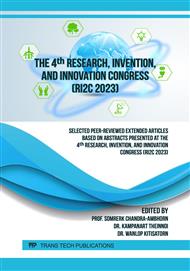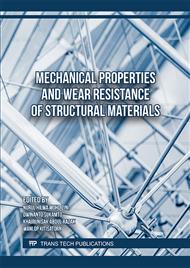[1]
D. Özyürek, An effect of weld current and weld atmosphere on the resistance spot weldability of 304L austenitic stainless steel, Materials & design, 29 (2008) 597-603.
DOI: 10.1016/j.matdes.2007.03.008
Google Scholar
[2]
R. Unnikrishnan, K.S.N. Satish Idury, T.P. Ismail, A. Bhadauria, S.K. Shekhawat, R.K. Khatirkar, S.G. Sapate, Effect of heat input on the microstructure, residual stresses and corrosion resistance of 304L austenitic stainless steel weldments, Materials Characterization, 93 (2014) 10-23.
DOI: 10.1016/j.matchar.2014.03.013
Google Scholar
[3]
S. Trigwell, G. Selvaduray, Effects of welding on the passive oxide film of electropolished 316L stainless steel, Journal of Materials Processing Technology, 166 (2005) 30-43.
DOI: 10.1016/j.jmatprotec.2004.07.091
Google Scholar
[4]
C. Doerr, J.-Y. Kim, P. Singh, J.J. Wall, L.J. Jacobs, Evaluation of sensitization in stainless steel 304 and 304L using nonlinear Rayleigh waves, NDT & E International, 88 (2017) 17-23.
DOI: 10.1016/j.ndteint.2017.02.007
Google Scholar
[5]
A.I. Muñoz, J.G. Antón, J. Guiñón, V.P. Herranz, Effect of nitrogen in argon as a shielding gas on tungsten inert gas welds of duplex stainless steels, Corrosion, 61 (2005) 693-705.
DOI: 10.5006/1.3278204
Google Scholar
[6]
H.-Y. Huang, Effects of shielding gas composition and activating flux on GTAW weldments, Materials & design, 30 (2009) 2404-2409.
DOI: 10.1016/j.matdes.2008.10.024
Google Scholar
[7]
Z. Zhang, H. Jing, L. Xu, Y. Han, L. Zhao, C. Zhou, Effects of nitrogen in shielding gas on microstructure evolution and localized corrosion behavior of duplex stainless steel welding joint, Applied Surface Science, 404 (2017) 110-128.
DOI: 10.1016/j.apsusc.2017.01.252
Google Scholar
[8]
P. Kah, J. Martikainen, Influence of shielding gases in the welding of metals, The International Journal of Advanced Manufacturing Technology, 64 (2013) 1411-1421.
DOI: 10.1007/s00170-012-4111-6
Google Scholar
[9]
H. Tsuge, Y. Tarutani, T. Kudo, The effect of nitrogen on the localized corrosion resistance of duplex stainless steel simulated weldments, Corrosion, 44 (1988) 305-314.
DOI: 10.5006/1.3583942
Google Scholar
[10]
W. Chuaiphan, L. Srijaroenpramong, Effect of hydrogen in argon shielding gas for welding stainless steel grade SUS 201 by GTA welding process, Journal of Advanced Joining Processes, 1 (2020) 100016.
DOI: 10.1016/j.jajp.2020.100016
Google Scholar
[11]
A. Forgas Júnior, J. Otubo, R. Magnabosco, Ferrite quantification methodologies for duplex stainless steel, Journal of Aerospace Technology and Management, 8 (2016) 357-362.
DOI: 10.5028/jatm.v8i3.653
Google Scholar
[12]
ASTM Standard D1141-98, Standard Practice for Preparation of Substitute Ocean Water, ASTM International, West Conshohocken, PA, 2021.
Google Scholar
[13]
T. Liptáková, M. Lovíšek, A. Alaskari, B. Hadzima, Surface state effect of welded stainless steels on corrosion behavior, Acta Metallurgica Slovaca, 22 (2016) 44-51.
DOI: 10.12776/ams.v22i1.627
Google Scholar
[14]
M. Somervuori, L.S. Johansson, M.H. Heinonen, D. Van Hoecke, N. Akdut, H. Hänninen, Characterisation and corrosion of spot welds of austenitic stainless steels, Materials and Corrosion, 55 (2004) 421-436.
DOI: 10.1002/maco.200303753
Google Scholar
[15]
J. Łabanowski, M. Głowacka, Heat tint colours on stainless steel and welded joints, Welding International, 25 (2011) 509-512.
DOI: 10.1080/09507116.2010.540837
Google Scholar
[16]
J. Tusek, M. Suban, Experimental research of the effect of hydrogen in argon as a shielding gas in arc welding of high-alloy stainless steel, International Journal of Hydrogen Energy, 25 (2000) 369-376.
DOI: 10.1016/s0360-3199(99)00033-6
Google Scholar
[17]
N. Anbarasan, S. Jerome, N. Arivazhagan, Argon and argon-hydrogen shielding gas effects on the laves phase formation and corrosion behavior of Inconel 718 gas tungsten arc welds, Journal of Materials Processing Technology, 263 (2019) 374-384.
DOI: 10.1016/j.jmatprotec.2018.07.038
Google Scholar
[18]
N. Stenbacka, On arc efficiency in gas tungsten arc welding, Soldagem & Inspeção, 18 (2013) 380-390.
DOI: 10.1590/s0104-92242013000400010
Google Scholar
[19]
B.-Y. Kang, Y.K. Prasad, M.-J. Kang, H. Kim, I.S. Kim, The effect of alternate supply of shielding gases in austenite stainless steel GTA welding, Journal of Materials Processing Technology, 209 (2009) 4722-4727.
DOI: 10.1016/j.jmatprotec.2008.11.035
Google Scholar
[20]
A.V. Bansod, A.P. Patil, A.P. Moon, S. Shukla, Microstructural and electrochemical evaluation of fusion welded low-nickel and 304 SS at different heat input, Journal of Materials Engineering and Performance, 26 (2017) 5847-5863.
DOI: 10.1007/s11665-017-3054-3
Google Scholar
[21]
W. Jiang, B. Wang, J. Gong, S. Tu, Finite element analysis of the effect of welding heat input and layer number on residual stress in repair welds for a stainless steel clad plate, Materials & design, 32 (2011) 2851-2857.
DOI: 10.1016/j.matdes.2010.12.037
Google Scholar
[22]
A. Murphy, Thermal plasmas in gas mixtures, Journal of Physics D: Applied Physics, 34 (2001) R151.
Google Scholar
[23]
A. Durgutlu, Experimental investigation of the effect of hydrogen in argon as a shielding gas on TIG welding of austenitic stainless steel, Materials & design, 25 (2004) 19-23.
DOI: 10.1016/j.matdes.2003.07.004
Google Scholar
[24]
J.C. Lippold, W.F. Savage, Solidification of austenitic stainless steel weldments: Part III--the effect of solidification behavior on hot cracking susceptibility, WELDING J., 61 (1982) 388.
Google Scholar
[25]
S. Sam, C.R. Das, V. Ramasubbu, S.K. Albert, A.K. Bhaduri, T. Jayakumar, E. Rajendra Kumar, Delta ferrite in the weld metal of reduced activation ferritic martensitic steel, Journal of Nuclear Materials, 455 (2014) 343-348.
DOI: 10.1016/j.jnucmat.2014.07.008
Google Scholar
[26]
W. Chuaiphan, L. Srijaroenpramong, Optimization of TIG welding parameter in dissimilar joints of low nickel stainless steel AISI 205 and AISI 216, Journal of Manufacturing Processes, 58 (2020) 163-178.
DOI: 10.1016/j.jmapro.2020.07.052
Google Scholar
[27]
W. Chuaiphan, L. Srijaroenpramong, Microstructure, mechanical properties and pitting corrosion of TIG weld joints alternative low-cost austenitic stainless steel grade 216, Journal of Advanced Joining Processes, 2 (2020) 100027.
DOI: 10.1016/j.jajp.2020.100027
Google Scholar
[28]
S. Kumar, A.S. Shahi, Effect of heat input on the microstructure and mechanical properties of gas tungsten arc welded AISI 304 stainless steel joints, Materials & design, 32 (2011) 3617-3623.
DOI: 10.1016/j.matdes.2011.02.017
Google Scholar
[29]
A.V. Bansod, S. Shukla, A.P. Patil, Microstructural, mechanical and intergranular corrosion behavior of cold work and thermal ageing of low nickel austenitic stainless steel, Materials Research Express, 6 (2019) 056508.
DOI: 10.1088/2053-1591/aad508
Google Scholar



